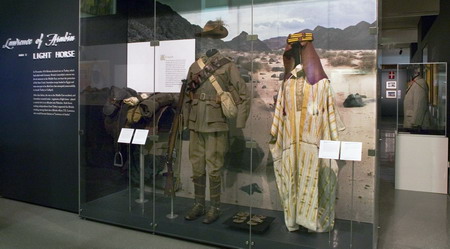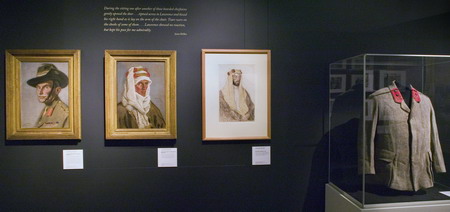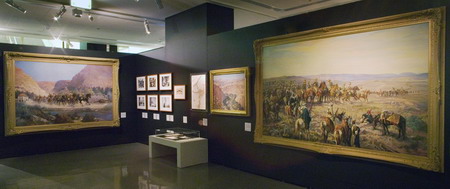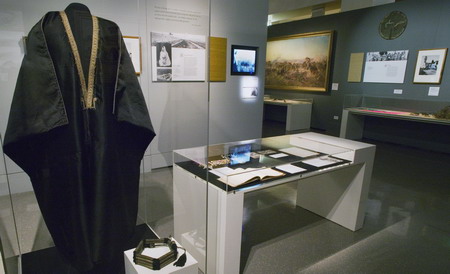review by Brad Manera

Unfortunately the exhibition is billed as another Australian War Memorial 'blockbuster', a description used so frequently it has lost impact. It is in reality a simple display of interesting objects that is not overburdened by a demanding storyline.
Lawrence of Arabia was Colonel Thomas Edward Lawrence, one of many British military advisers who operated with indigenous irregular forces in the Middle East during the Sinai Palestine campaign of 1916 to 1918. He was probably the most successful of these officers and, because an American journalist 'discovered' him, he was certainly the most remembered. Lawrence had a passionate interest in Middle Eastern culture and, like many soldiers in that position in wars before and since, was drawn into local politics.
The Australian Light Horse formed a very distinctive national force within the Egyptian Expeditionary Force, the British and allied army that drove the Ottoman Turks and their German allies back across the Sinai desert in 1916, into Palestine in 1917, then on to capture Damascus on the first day of October 1918, shortly before the armistice. The Australian Light Horse is most famous for its mounted charge at Beersheba, which has entered Australian folklore as the last great cavalry charge.
The exhibition is populated by objects of extraordinary cultural and historical significance, including several sets of the Arab robes that Lawrence wore, both before the war when he explored the Middle East as an archaeologist, and during the war as a military leader. These robes are displayed at a height commensurate with Lawrence's short stature (he was only about 160 centimetres tall). Other uniforms include the heavily decorated best service dress tunic worn by Lieutenant General Sir Harry Chauvel, Australia's first corps commander, and the tailor-made light khaki tunic worn by Brigadier William Grant, commander of the Australian 4th Light Horse Brigade, the unit that made the charge at Beersheba.
There are even some artefacts from those who have been lost to history, including an anonymous Ottoman soldier's poorly made and threadbare tunic and the obviously handmade peasant vest worn with it to keep out the desert chill. We can only wonder if the vest was the innovative creation of a skilled but inadequately equipped common soldier in the field, or a gift from loved ones who missed him and cared for his wellbeing from afar.
Some of the material for the exhibition has been sourced from overseas institutions, including the Imperial War Museum in London and the Fashion Museum at Bath. One of my favourite objects is a particularly well provenanced example of the ubiquitous .303 rifle. This Short, Magazine Lee-Enfield, Mk III, British service rifle was captured and inscribed by the Turks at Gallipoli in 1915. It was presented to Prince Faisal by Enver Pasha himself. When his loyalties changed, Faisal in turn presented it to Lawrence just before Christmas 1916. Lawrence used the weapon during the war and notched the wooden stock with each of his kills, and after the war he made it a gift to King George V. It is still in the collection of the British Royal Family and on loan to the exhibition.
The exhibition also explores the mythology that has grown around its subjects. The printed works displayed include first editions of Sir Henry Gullett's The Australian Imperial Force in Sinai and Palestine, Volume VII of the Official History of Australia in the War 1914–1918 and Lawrence's autobiographical Seven Pillars of Wisdom. Advertising posters for the films that immortalised both Lawrence and the Light Horse — Forty Thousand Horsemen by Charles Chauvel (1940) and David Lean's 1962 epic Lawrence of Arabia, starring Peter O'Toole in the title role — are also displayed in the gallery.
The major problem for the exhibition is in living up to its title, for in actuality there are very few links between Lawrence of Arabia and the Australian Light Horse. For almost the entire campaign they fought different enemies, employed totally different tactics and were involved in operations hundreds of kilometres apart. Apparently they did not even share the same political aims. The differences are not explored in the exhibition and it does not even expend much energy searching for links. My inclination would have been to call the exhibition something like 'Treasures of the Sinai Palestine campaign' though that would have sacrificed two immediate sources of popular appeal.
One of the few Australian objects with a direct link to Lawrence is the flying log kept by the Australian aviator Captain (later Sir) Ross Smith MC DFC, a former 3rd Light Horse Regiment trooper who joined the Australian Flying Corps. In the log there is an entry that records Colonel Lawrence flying as Smith's passenger.
The key issues of the Sinai Palestine campaign in which both of the subjects of the exhibition had any significant involvement were the capture of Damascus a month before the armistice, and the Arab revolts, including the Egyptian Uprising, that occurred shortly after the war. Disappointingly, these events are not examined in detail or given any fresh perspective. This is a missed opportunity, given the resonance of the Australian Light Horse in this country (their name lives on in a recently opened series of motorway flyovers in western Sydney) and the enduring international interest in conflict in the Middle East with which Lawrence's name and reputation is frequently linked by a media searching for historical precedent.
Like many Australians of my generation, I was raised with the stories of the light-horsemen of my grandfather's generation and encouraged to be inspired by their example. As aging veterans, a few of them still led the Perth march down the Terrace on Anzac Day and gathered beneath a monument to the 10th Light Horse in Kings Park that bore the dedication 'to our glorious dead'. There was further evidence of them in stone and bronze: family holidays to Albany were not complete without a visit to the statue dedicated to the Desert Mounted Column at Mt Clarence. And aged family members like irritable great-aunty Evelyn had a huge, hand-tinted portrait from about 1917 of her late husband (former Corporal) Bob Coverly in his 10th Light Horse Regiment uniform above the mantelpiece to help preserve his memory. We knew that it was our Western Australian light-horsemen who were first into Damascus despite Lawrence's claim in Seven Pillars, and perpetuated in David Lean's movie.
So why is this not the theme for an exhibition with the title Lawrence of Arabia and the Light Horse?
Given the art and photographic collection at the War Memorial surely it could have been possible to recreate the impression of the extraordinary scene in the grand hall of the imposing Serai in Damascus when three dusty light-horsemen with revolvers drawn were confronted by 'a large gathering, clad in the glittering garb of eastern officialdom'. The impeccably dressed and decorated Emir Said rose from his 'high-backed gold and plush chair' and greeted them: 'In the name of the city of Damascus, I welcome the first of the British Army'.[1] Damascus surrendered to Major ACN 'Harry' Olden DSO, a dentist from Narrogin, north of Albany in Western Australia. It was the same Major Olden and his men of the 10th Light Horse Regiment who, five months later, played a significant role in quelling the Egyptian Uprising.
In 1956 a memorial statue at Port Said to the Australian Light Horse was destroyed by rioting Egyptians. The damaged bronze head of the horse that was part of that statue was recovered and returned to Australia. For years it was displayed at the Residency Museum at Albany, a poignant reminder of the inspiration for the statue on Mount Clarence. It was recently and reluctantly sent to the Australian War Memorial in Canberra where it is packed away in a repository. Perhaps even Lawrence of Arabia would have shared the view that there could have been a place for the horse's head in drawing the elements of Lawrence of Arabia and the Light Horse together and suggesting a link to ongoing violence in that troubled part of the world?
Brad Manera is head curator, Hyde Park Barracks Museum, Sydney.
| Institution: | Australian War Memorial |
| Curatorial team: | Mal Booth (curator), Robyn Van Dyk (assistant curator), Susie Quinn (project manager), Robert Fisher (loans officer), Bianca Guthrie (project officer), Robert Nichols |
| Design: | Arketype |
| Exhibition space: | approx 110 square metres |
| Venue/dates: |
Australian War Memorial, Canberra, 7th December 2007 – 25 May 2008 |
